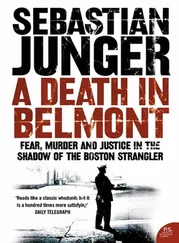“My first objective was to get fifty meters away from them,” Childs says. “And then five hundred meters, and then five kilometers. I knew that every bit increased the area they had to search by the square of the distance. And I knew there was no way this guy Turki was going to scatter his crew all over creation looking for me. He couldn’t afford to look for me for more than six hours, so if I could stay away from them for that long, my only problem would be not being seen by the nomads.”
That meant hiding during the day and traveling at night, which strongly favored an escape after dark. That was fortunate, because Childs had one iron-clad reason for getting up over and over again during the night: Dysentery was still raging through his insides. The militants always posted a sentry after dark, but the hostages weren’t tied up when they slept, so the sight of Childs getting up to relieve himself was by now routine.
In contrast with Childs, the other hostages seemed to be doing fairly well. The two Brits, Wells, twenty-four, and Mangan, thirty-four, were depressed but physically strong, and Hutchings was fully in his element. When Mangan came down with altitude sickness, Hutchings had him pressure-breathing and rest-stepping as he walked; when the group got lost in a whiteout, he took charge and told them which way to go. At one point Wells muttered how he would like to grab one of the hand grenades and blow all the militants away, but Hutchings was always personable and helpful. “It’s a lot tougher to kill a smiling face,” he said. Hutchings had years of psychological training; if anyone could manipulate the situation, he could.
It wasn’t until the fourth day, as they were crossing yet another valley, that the militants made their first mistake: They visited a familiar place. It wasn’t much, but it was all Childs had.
“We were in the valley that the pilgrims take to Amarnath Cave,” Childs says. “And Don knew where we were; he’d been there before. He said, ‘Okay, down the valley is Pahalgam, and up the valley is the cave.’”
Childs thought about that for the rest of the day. He wasn’t going to be able to keep up with the group for long, and Turki wouldn’t hesitate to have him shot. Not only would that free up the group, but it would also send a message to the authorities, who obviously hadn’t given in to the militants yet. If he were going to escape, he’d have to do it soon.
“So, are we going to spend the night here?” Childs asked Turki that afternoon, as they were taking a break. He knew the answer, but he wanted to hear what Turki had to say. “No, too much danger,” Turki replied, waving his arm down the valley: Indian military. They wouldn’t dare spend much time searching for someone, in other words.
That night the militants made camp along the east branch of the Lidder River, sleeping in a cluster of stone huts generally used by pilgrims on their way to Amarnath Cave. Childs, rolled up in a horse blanket, lay on the dirt floor of a hut and considered his possible avenue of escape. The camp was at the mouth of two huge valleys that fed into the valley leading to Pahalgam, and Childs’s plan was to escape by climbing up, in the opposite direction of what the militants would expect. He’d hide in the snowfields before dawn, stay until dark, and then start down toward Pahalgam. It was a three-day walk, he figured; he had no food, no bedding, and the valley was filled with nomads who might report his location to the militants. It was, at best, a long shot, but it was better than the odds he had now.
Then, exhausted by four days of forced marches, Childs fell asleep.
“There had been other opportunities to escape, but of course you never know if it’s the right time,” says Childs. “It’s not a movie, where you know when it’s going to end. You keep asking yourself, ‘Is this the best time, or will there be a better time with less risk?’ It took a huge effort to focus my thoughts and say, ‘Okay, you’ve got to do this now. You’ve got to do it when you’re tired and not feeling well.’”
Childs woke up in the middle of the night. It was quiet except for the sound of people snoring and the crash of the river. The dysentery was rolling through his system, so he fumbled in the dark and grabbed his hiking boots—knocking over a metal grate in the process—and crept out of the hut. Ordinarily the sentry would greet him and escort him out of camp. But this time no one stirred—the sentry seemed to be asleep. Childs walked out of camp, relieved himself, and then stole back into bed, wondering what to do.
“You can be passive and not make a decision that may save your life,” he says, “or you can accept death as a possibility. That was the crux of the whole thing.”
Childs lay in bed for an hour, preparing himself, and then he got up again. He decided that if anyone stopped him, he’d just claim he was having another bout of dysentery. He thought about waking up the other hostages, but there didn’t seem to be any way to do that quietly; the others also lacked his pretext for getting up. Childs stepped out of the hut and waited for someone to say something; silence. He edged out of the firelight into the darkness beyond the huts; more silence. There was always the possibility that someone was watching him surreptitiously—or even had a gun trained on him—but that was a chance he had to take. He stood motionless for a moment, frozen at the point of no return, and then he started to run.
“I thought I was in their cross hairs the whole time,” he says. “It was like a dream where you run and run and you’re not getting anywhere because your feet are bogging down. I kept expecting to hear a ruckus behind me, but I never saw any of them again.”
Childs took off straight up a ridge between the two valleys. He was in his stocking feet, and all he had on was long underwear, Gore-Tex pants, a wool shirt, and a pair of pile pants wrapped around his head. He walked and ran as hard as he could until the ridge got too steep to climb without boots, and then he put them on and kept going. He knew the militants would wake up early for morning prayers, and he had to get as far away as possible before then. He hammered upward for the next three hours, and when dawn came, he crept into a cleft in a rock, drew in a few stones to conceal himself, and settled down to wait. As it got lighter, he noticed that anyone walking along the ridge would stumble right into him, so he violated his rule against traveling during the day and continued higher up. He was in the snow zone now, really rugged country; the next hiding spot he found seemed perfect, until it became apparent that he was resting on solid ice. He wound up moving to a small patch of moss on a hillside. There were glaciers and peaks all around him, and he was sure no one would follow him up that high; he was at least at twelve thousand feet.
By midmorning a drizzling sleet had started to fall, and Childs endured that for a few hours—resting on the moss, dozing from time to time—before starting out for Pahalgam. He was almost down at the bottom of one of the side canyons when he heard a helicopter. The sound of the rotors faded in and out, then seemed to head straight toward him. Since he hadn’t heard any aircraft in five days, his first thought was that there must have been a negotiated release of the hostages and now he was stranded in the high mountains with no food and no way to call for help.
“I stood there kind of dumbfounded,” he says, “and I started waving my pants around over my head. The pilot circled, and I could see there was a soldier in there; he had his gun pointed at me. I was a mess by that point. I hadn’t bathed in five days and had mud smeared all over me and looked like a wild man of the mountains. The pilot landed on one skid, I ran up, and [a soldier] said, ‘Are you German?’ I said, ‘No, I’m American. I just escaped from the militants.’ He said, ‘It’s a miracle from God,’ and hauled me on board.”
Читать дальше












